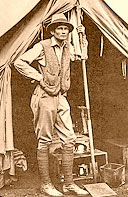|
Hiram Bingham, the American explorer who found the
ruins of Machu Picchu in 1911, wrote:
No less striking than the remarkable system
of highways were the irrigation ditches which ran for scores of miles in
the Central Andes. The height of the mountains, often rising to 18,000
or 20,000 feet, forces the moisture-laden winds coming from the east
across the humid basin of the Amazon to deposit their burden in heavy
rains on the eastern slopes of the great Andean chain. Little rain ever
falls on the western slopes. On fact, one of the greatest deserts in the
world is the two-thousand-mile coastal strip extending from central
Chile to Ecuador.

The soil in the bottom of the valleys that
cross this region is rich enough to grow luxuriant crops of sugar cane,
cotton, and corn, but it needs to be regularly irrigated in order to do
so. For this purpose the rivers, fed by melting snow in the high Andes,
are deflected into irrigation ditches which follow the contours of the
valleys for many miles. Inca engineers must have had good eyes and a
fine sense of grading since they had none of the instruments on which
our engineers depend to lay out similar projects. Imagine running a
perfect contour for twenty miles!
Not only did the Incas provide their fields
with necessary water, they also saw to it that their towns and cities
had adequate supplies and for that purpose built fine aqueducts.

Source:
‘Lost City of the Incas, The Story of Machu
Picchu and its Builders’ by Hiram Bingham
The American explorer who found the ruins of Machu Picchu in 1911.

Hiram Bingham at Machu Picchu
The inspiration for Indiana Jones?
|